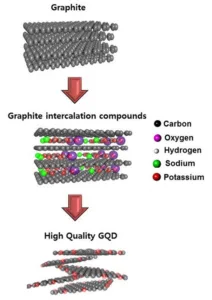The first graphene quantum dots, made with high-quantum-yield nanodots (obtained through graphite intercalation compound synthesis), have enabled luminance above 1,000cd/m² in OLEDs.
Researchers at the Korea Advanced Institute of Science and Technology (KAIST) worked on the quantum dots, in which graphene replaces cadmium. Carbon has recently begun to be used as a replacement for cadmium; however, carbon QDs (CQDs) developed using synthetic methods are still behind cadmium components, in terms of desired brightness and optical property control. The researchers write that it is important to develop strategies to synthesise high-quality CQDs on a large scale, as well as to gain a better understanding of the fluorescence mechanism.
Because of graphene’s simpler chemical structure, QDs using the material (GQDs) may provide a good model system for understanding the underlying mechanics of fluorescence. They may even replace CQDs in compact or flexible light-emitting systems.
Work by the researchers supported the existence of a subdomain in GQDs. A new way of synthesising the components could increase the number of subdomains; this would enable the development of GQDs with low oxidation, higher photoluminescence (PL) efficiency and PL tunability.
A synthetic procedure has been developed to fabricate high-quality GQDs from graphite intercalation compounds (GICs). A GIC dissolution process in water, using graphite and sodium potassium tartrate, enables the generation of a large number of GQDs (>50% yield) in the stable form of a (roughly) 5nm GQD powder. According to the researchers, this method is cost-effective, eco-friendly and scalable. The GQDs formed this way emit at around 400nm – the same emission wavelength achieved in GQDs fabricated from chemical vapour deposition-grown graphene.
The new GQDs have a quantum yield of 4.5%, enabling the luminance of OLEDs to be increased. The GQDs were added to the active poly(N-vinylcarbazole) (PVK) matrix layer of an OLED. Careful design of the layer configuration was able to balance the hole and electron injection, resulting in the 1,000+ cd/m² GQD-LEDs. The components also appeared to provide additional carrier transport and injection pathways, resulting in an enhancement to the overall current density.
Efficiency of the new GQD-LEDs is currently much lower than that found in conventional LEDs, but it is hoped that this can be increased in the near future.

